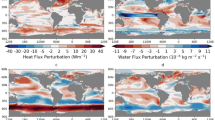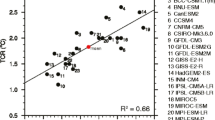Abstract
The global mean surface temperature (GMST) response of HadCM3 to a 1,000 year 4×CO2 forcing is analysed using a transfer function methodology. We identify a third order transfer function as being an appropriate characterisation of the dynamic relationship between the radiative forcing input and GMST output of this Atmosphere-Ocean General Circulation Model (A-OGCM). From this transfer function the equilibrium climate sensitivity is estimated as 4.62 (3.92–11.88) K which is significantly higher than previously estimated for HadCM3. The response is also characterised by time constants of 4.5 (3.2–6.4), 140 (78–191) and 1,476 (564–11,737) years. The fact that the longest time constant element is significantly longer than the 1,000 year simulation run makes estimation of this element of the response problematic, highlighting the need for significantly longer model runs to express A-OGCM behaviour fully. The transfer function is interpreted in relation to a three box global energy balance model. It was found that this interpretation gave rise to three fractions of ocean heat capacity with effective depths of 63.0 (46.7–85.4), 1291.7 (787.3–2,955.3) and 2,358.0 (661.3–17,283.8) meters of seawater, associated with three discrete time constants of 4.6 (3.2–6.5), 107.7 (68.9–144.3) and 537.1 (196.2–1,243.1) years. Given this accounts for approximately 94% of the ocean heat capacity in HadCM3, it appears HadCM3 could be significantly more well mixed than previously thought when viewed on the millennial timescale.




Similar content being viewed by others
Notes
In Grieser and Schönwiese (2001) the cascade model they use has three layers, but the top atmospheric layer has no inertia, hence making their system second order m = n = 2.
A rational continuous time transfer function is stable only if none of its poles lie in the right hand portion of the complex s plane. That is to say, for a stable response (i.e. an impulse response that decays to zero) each pole must be less than zero. For a conservative response (i.e. an impulse response that stabilises at a non-zero value) one or more poles may be equal to zero and if any pole is greater than zero then the impulse response is unstable and will grow exponentially.
The range given in the brackets is the 95% confidence interval derived from the 7 × 103 ensemble.
The HadCM3 uses a calendar year that consists of 12, 30 day months.
β is estimated by regressing GMST on the grid aggregation of the surface ocean mixed layer temperature (Parker et al. 1995).
References
Claussen M et al (2002) Earth system models of intermediate complexity: closing the gap in the spectrum of climate system models. Clim Dyn 18:579–586. doi:10.1007/s00382-001-0200-1
Dickinson RE (1981) Convergence rate and stability of ocean-atmosphere coupling schemes with a zero-dimensional climate model. J Atmos Sci 38:2112–2120. doi:10.1175/1520-0469(1981)038<2112:CRASOO>2.0.CO;2
Dowell EH (1996) Eigenmode analysis in unsteady aerodynamics: reduced order models. Am Inst Aeronautics Astronautics J 34:1578–1588
Eickhout B, den Elzen MGJ, Kreileman GJJ (2004) The atmosphere-ocean system of IMAGE 2.2: a global model approach for atmospheric concentrations, and climate and sea level projections. RIVM report 481508017/2004
Enting IG (2007) Laplace transform analysis of the carbon cycle. Environ Model Softw 22:1488–1497. doi:10.1016/j.envsoft.2006.06.018
Enting IG, Trudinger CM (2002) Modelling earth system change: I. Validating parameterisations for attribution calculations. CSIRO Atmospheric Research Technical Paper 56
Gilliland RL (1982) Solar, volcanic, and CO2 forcing of recent climatic changes. Clim Change 4:111–131
Godfrey K (1982) Compartmental models and their application. Academic Press, London
Gregory JM, Ingram WJ, Palmer MA, Jones GS, Stott PA, Thorpe RB, Lowe JA, Johns TC, Williams KD (2004) A new method for diagnosing radiative forcing and climate sensitivity. Geophys Res Lett 31:L03205. doi:10.1029/2003GLO18747
Grieser J, Schönwiese C-D (2001) Process, forcing, and signal analysis of global mean temperature variations by means of a three-box energy balance model. Clim Change 48:617–646. doi:10.1023/A:1005629309829
Harvey LDD (2000) Global warming: the hard science. Prentice Hall, Edinburgh, 233 pp
Harvey LDD, Schneider SH (1985) Transient climate response to external forcing on 100–104 year time scales part 1: experiments with globally averaged, coupled atmosphere and ocean energy balance models. J Geophys Res 90:2191–2205. doi:10.1029/JD090iD01p02191
Harvey LDD, Gregory J, Hoffert M, Jain A, Lal M, Leemans R, Raper S, Wigley T, de Wolde J (1997) An introduction to simple climate models used in the IPCC second assessment report. IPCC Technical Paper 2
Hasselmann K, Hasselmann S, Giering R, Ocana V, Storch HV (1997) Sensitivity study of optimal CO2 emission paths using a simplified structural integrated assessment model (SIAM). Clim Change 37:345–386. doi:10.1023/A:1005339625015
Henderson-Sellers A, McGuffie K (1987) A climate modeling primer. Wiley, Chichester, 55 pp
Hoffert MI, Calligari AJ, Hseich C-T (1980) The role of deep sea heat storage in the secular response to climate forcing. J Geophys Res 85:6667–6679. doi:10.1029/JC085iC11p06667
Hooss G, Voss R, Hasselman K, Maier-Reimer E, Joos F (2001) A nonlinear impulse response model of the coupled carbon cycle-climate system (NICCS). Clim Dyn 18:189–202. doi:10.1007/s003820100170
Huntingford C, Cox PM (2000) An analogue model to derive additional climate change scenarios from existing GCM simulations. Clim Dyn 16:575–586. doi:10.1007/s003820000067
Jarvis AJ, Young PC, Taylor CJ, Davies WJ (1999) An analysis of the dynamic response of stomatal conductance to a reduction in humidity over leaves of Cedrela odorata. Plant Cell Environ 22:913–924. doi:10.1046/j.1365-3040.1999.00446.x
Joos F, Bruno M, Fink R, Siegenthaler U, Stocker TF, LeQuere C (1996) An efficient and accurate representation of complex oceanic and biospheric models of anthropogenic carbon uptake. Tellus 48B:397–417
Joshi MM, Gregory JM, Webb MJ, Sexton DMH, Johns TC (2008) Mechanism for the land/sea warming contrast exhibited by simulations of climate change. Clim Dyn 30:455–465. doi:10.1007/s00382-007-0306-1
Kester DR (2006) The world oceans. World book encyclopedia, vol 14
Kirchner JW, Feng X, Neal C (2001) Catchment scale advection dispersion as a mechanism for fractal scaling in stream tracer concentrations. J Hydrol (Amst) 254:82–101. doi:10.1016/S0022-1694(01)00487-5
Li S (2009) Simplicity from complexity: an Earth systems perspective. PhD thesis. Lancaster University, UK
Li S, Jarvis AJ, Leedal D (2009) Are response function representations of the global carbon cycle ever interpretable? Tellus 61B:361–371
Lowe J (2003) Parameters for tuning a simple climate model. Accessed from http://unfccc.int/resource/brazil/climate.html
McGuffie K, Henderson-Seller A (2001) Forty years of numerical climate modeling. Int J Climatol 21:1067–1109. doi:10.1002/joc.632
Meinshausen M, Raper SCB, Wigley TML (2008) Emulating IPCC AR4 atmosphere-ocean and carbon cycle models for projecting global-mean, hemispheric and land/ocean temperatures: MAGICC 6.0. Atmos Chem Phys Discuss 8:6153–6272
Moore B (1981) Principle component analysis in linear systems: controllability, observability, and model reduction. IEEE Trans Automat Contr 26:17–32. doi:10.1109/TAC.1981.1102568
Nise NS (2004) Control systems engineering. Wiley, New York
Parker DE, Jones PD, Bevan A, Folland CK (1995) Interdecadal changes of surface temperature since the late 19th century. J Geophys Res 99:14373–14399. doi:10.1029/94JD00548
Randall DA et al (2007) Climate models and their evaluation. In: Solomon S et al (eds) Climate change 2007: the physical basis of climate change. Contribution of Working Group I to the fourth assessment report of the IPCC. Cambridge University Press, Cambridge, pp 589–662
Raper SCB, Gregory JM, Osborn TJ (2001) Use of an upwelling-diffusion energy balance climate model to simulate and diagnose A/OGCM results. Clim Dyn 17:601–613. doi:10.1007/PL00007931
Raper SCB, Gregory JM, Stouffer RJ (2002) The role of climate sensitivity and ocean heat uptake on AOGCM transient temperature response. J Clim 15:124–130. doi:10.1175/1520-0442(2002)015<0124:TROCSA>2.0.CO;2
Roe GH, Barker MB (2007) Why is climate sensitivity so unpredictable? Science 318:629–632. doi:10.1126/science.1144735
Schneider SH, Thompson SL (1981) Atmospheric CO2 and climate – importance of the transient response. J Geophys Res 86:3135–3147. doi:10.1029/JC086iC04p03135
Stouffer RJ (2004) Time scales of climate response. J Clim 17:209–217. doi:10.1175/1520-0442(2004)017<0209:TSOCR>2.0.CO;2
Stouffer RJ, Manabe S (1999) Response of a coupled ocean-atmosphere model to increasing atmospheric carbon dioxide: sensitivity to the rate of increase. J Clim 12:2224–2237. doi:10.1175/1520-0442(1999)012<2224:ROACOA>2.0.CO;2
Tang D, Kholodar D, Juang J-N, Dowell EH (2001) System identification and proper orthogonal decomposition applied to unsteady aerodynamics. Am Inst Aeronautics Astronautics J 39:1569–1576
Watterson IG (2000) Interpretation of simulated global warming using a simple model. J Clim 13:202–214. doi:10.1175/1520-0442(2000)013<0202:IOSGWU>2.0.CO;2
Watts RG, Morantine MC, Achutarao K (1994) Timescales in energy balance climate models. 1. The limiting case solutions. J Geophys Res 99:3631–3641. doi:10.1029/93JD01867
Wigley TML, Raper SCB (1987) Thermal expansion of sea water associated with global warming. Nature 330:127–131. doi:10.1038/330127a0
Wigley TML, Schlesinger ME (1985) Analytical solution for the effect of increasing CO2 on global mean temperature. Nature 315:649–652. doi:10.1038/315649a0
Wigley TML, Ammann CM, Santer BD, Raper SCB (2005) Effect of climate sensitivity on the response to volcanic forcing. J Geophys Res 110(D9):D09107. doi:10.1029/2004JD005557
Young PC, Garnier H (2006) Identification and estimation of continuous-time, data-based mechanistic models for environmental systems. Environ Model Softw 21:1055–1072. doi:10.1016/j.envsoft.2005.05.007
Zickfeld K, Slawig T, Rahmstorf S (2004) A low-order model for the response of the Atlantic thermohaline circulation to climate change. Ocean Dyn 54:8–26. doi:10.1007/s10236-003-0054-7
Acknowledgement
We would like to express our gratitude to Tim Johns in the Hadley Centre who provided both the HadCM3 simulation data and useful discussion. We would also like to thank Ian Watterson and an anonymous referee for helpful comments which significantly improved this paper.
Author information
Authors and Affiliations
Corresponding author
Appendices
Appendix A: The equivalence between transfer function, sum of exponential and ordinary differential equation representations of linear dynamic systems
In Eq. 1 we presented the generic linear, continuous time transfer function structure with zero initial conditions, i.e.
If we take s m,n = d m,n/dt m,n in this zero initial condition case then Eq. A1 can be re-arranged to give a generic linear, continuous time ODE of the form,
For the m = n case, Eq. A1 can also be re-expressed in a partial fraction expansion form,
where p i {i = 1…n} are the poles of H(s). Providing p i < 0 and real, then -p −1 i are the time constants (or e-folding times) T i of each first order element in Eq. A3. The equilibrium gains (or amplitudes) G i of each first order element are simply -r i /p i .
Taking the inverse Laplace transform L −1 of Eq. A3 for this m = n case gives the SEs response function,
Appendix B: The relationship between surface ocean mixed layer heat capacity (c s) and coupled atmosphere-surface ocean mixed layer heat capacity (c 1)
Assuming the thermal inertia of the atmosphere is approximately zero and ignoring any deep ocean feedbacks, the atmosphere and surface ocean mixed layer energy balances can be written in the following TF forms,
where x a is the atmospheric temperature response. Inserting (B1a) into (B1b), one obtains
Likewise, expressing the coupled atmosphere-surface ocean mixed layer energy balance in its TF form, again ignoring any deep ocean feedback (c.f. Eq. 5a) gives,
Assuming x a ∝x s (Hoffert et al. 1980; Parker et al. 1995; Eickhout et al. 2004; Joshi et al. 2008) then x 1 = βx s , which holds for the HadCM3 experiment considered here. Then, equating βc 1 in Eq. B3 with c s /f 0 k as /(λ + f 0 k as ) in Eq. B2 gives,
Rights and permissions
About this article
Cite this article
Li, S., Jarvis, A. Long run surface temperature dynamics of an A-OGCM: the HadCM3 4×CO2 forcing experiment revisited. Clim Dyn 33, 817–825 (2009). https://doi.org/10.1007/s00382-009-0581-0
Received:
Accepted:
Published:
Issue Date:
DOI: https://doi.org/10.1007/s00382-009-0581-0




